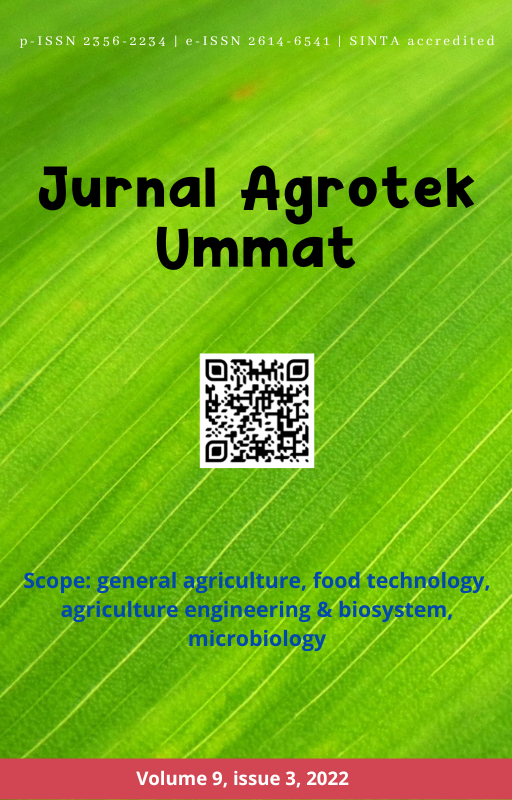Economic analysis of tomato cultivation on dryland with drip irrigation technique
DOI:
https://doi.org/10.31764/jau.v9i3.9767Keywords:
drip irrigation technique, economic analysis, eligibility level, silver black plastic, tomato cultivationAbstract
Economic analysis is one of the important parameters in applying drip irrigation techniques. For the community, this drip irrigation technique is a new technology so it needs to be analyzed with an economic approach. The purpose of this study was to analyze the economics of tomato cultivation by applying drip irrigation techniques on dry land. The research design used was a Randomized Block Design (RAK) with the following treatments, T1 (beds without mulch), T2, (beds with Straw mulch, and T3 (beds with silver-black plastic mulch). , production costs, farmer's income, and business feasibility by looking at the value of the B/C Ratio. Furthermore, the data from the analysis were tested using mathematical equations with the help of excel. The results of the analysis showed that the highest tomato production by applying drip irrigation techniques was found in T3 with a production yield of 896 quintals/ha with a total cost of IDR 369.000,000/ha, the highest level of income was also found in P3 of IDR 437,4000,000/ha and the highest B/C Ratio value was also found in T3, namely 1.18. So based on the results and discussion it can be concluded that economically for tomato cultivation by applying drip irrigation techniques should use bed cover using mulch a Silver Black Plastic.
References
Amuddin, A. And Sumarsono, J. (2015) ‘Rancang Bangun Alat Penyiraman Tanaman Dengan Pompa Otomatis Sistem Irigasi Tetes Pada Lahan Kering’, Jurnal Ilmiah Rekayasa Pertanian Dan Biosistem. Doi: 10.29303/Jrpb.V3i1.8.
Ardhona, S. Et Al. (2013) ‘Pengaruh Pemberian Dua Jenis Mulsa Dan Tanpa Mulsa Terhadap Karakteristik Pertumbuhan Dan Produksi Tanaman Cabai Merah (Capsicum Annum L) PADA DATARAN RENDAH’, Jurnal Agrotek Tropika. Doi: 10.23960/Jat.V1i2.1988.
Astutik, A. D., Koesriharti And Aini, N. (2018) ‘Pertumbuhan Dan Hasil Tanaman Cabai Merah( Capsicum Annuum L .) Dengan Aplikasi Plant Growth Promoting Rhizobacteria Dan Mulsa Jerami’, Jurnal Produksi Tanaman.
Ekaputra, E. G. Et Al. (2017) ‘Rancang Bangun Sistem Irigasi Tetes Untuk Budidaya Cabai (Capsicum Annum L.) Dalam Greenhouse Di Nagari Biaro, Kecamatan Ampek Angkek, Kabupaten Agam, Sumatera Barat’, Jurnal Irigasi. Doi: 10.31028/Ji.V11.I2.103-112.
Ginting, S., Rahmandani, D. And Indarta, A. H. (2019) ‘Optimasi Pemanfaatan Air Embung Kasih Untuk Domestik Dan Irigasi Tetes’, Jurnal Irigasi. Doi: 10.31028/Ji.V13.I1.41-54.
Joubert, M. D., Ridwan, D. And Pratiwi, R. M. (2017) ‘Performance Of Groundwater Irrigation System On Drip Irrigation Using Solar Water Pump’, Jurnal Irigasi. Doi: 10.31028/Ji.V11.I2.125-132.
Marampa, Y. P. And Maskan (2014) ‘Analisis Kelayakan Finansial Budidaya Tanaman Karet (Hevea Brasiliensis) Skala Rakyat Di Kampung Tering Seberang Kecamatan Tering Kabupaten Kutai Barat’, Jurnal Agriculture And Forestry.
Mulyana, A. And Muslih, I. (2020) ‘Pengaruh Biaya Produksi Dan BIAYA Operasional Terhadap Laba Bersih’, Jurnal Riset Akuntansi. doi: 10.34010/jra.v12i1.2600.
Mulyani, A. and Suwanda, M. H. (2020) ‘Pengelolaan Lahan Kering Beriklim Kering untuk Pengembangan Jagung di Nusa Tenggara’, Jurnal Sumberdaya Lahan. doi: 10.21082/jsdl.v13n1.2019.41-52.
Nurhafsah, N. et al. (2021) ‘Analisis Usahatani Cabai di Luar Musim Berdasarkan Penerapan Komponen Budidaya Cabai Merah di Provinsi Sulawesi Barat’, Jurnal Teknotan. doi: 10.24198/jt.vol15n1.2.
Pertiwi, A. et al. (2021) ‘Sistem Otomatisasi Drip Irigasi Dan Monitoring Pertumbuhan Tanaman CABAI BERBASIS INTERNET OF THINGS’, Sebatik. doi: 10.46984/sebatik.v25i2.1623.
Phocaides, A. (2007) ‘CHAPTER 7: Water quality for irrigation’, Handbook of Pressurized Irrigation Techniques.
Putra, D. D. D. (2021) ‘Analisis Pendapatan Petani Cabai Rawit Mitra Pt Tunas Agro Persada Sayung Kabupaten Demak’, Jurnal Agristan. doi: 10.37058/ja.v3i1.3116.
Ridwan, D. (2013) ‘Model of Drip Irrigation Network with Local Material Based for Agricultural Small Land’, Jurnal Irigasi. doi: 10.31028/ji.v8.i2.90-98.
Selvamurugan, M. et al. (2018) ‘Effect of drip fertigation and plastic mulching on growth and yield of tomato’, Journal of Applied Horticulture. doi: 10.37855/jah.2018.v20i01.14.
Downloads
Published
Issue
Section
License
Authors who publish articles in Jurnal Agrotek Ummatagree to the following terms:- Authors retain copyright of the article and grant the journal right of first publication with the work simultaneously licensed under a CC-BY-SA or The Creative Commons Attribution–ShareAlike License.
- Authors are able to enter into separate, additional contractual arrangements for the non-exclusive distribution of the journal's published version of the work (e.g., post it to an institutional repository or publish it in a book), with an acknowledgment of its initial publication in this journal.
- Authors are permitted and encouraged to post their work online (e.g., in institutional repositories or on their website) prior to and during the submission process, as it can lead to productive exchanges, as well as earlier and greater citation of published work (See The Effect of Open Access).

